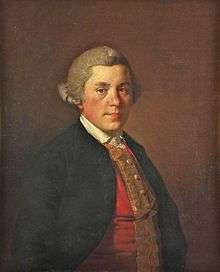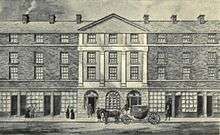Thomas Parke (merchant)
Thomas Parke (1729/30 – 1819)[1] was a Liverpool merchant, banker and privateer.[2] He was part of the complex network of business interests and finance behind the African and Atlantic slave trade of the later 18th century.

Life
He originally from Swaledale, Yorkshire, the son of Thomas and Hannah Parke of Low Row; his father was a hosier and lead miner. He went into business as a linen merchant, initially with his brother John. His brother-in-law Christopher Wilson I of Kendal was another hosier, and Thomas Parke's merchant ventures included exporting Wilson's goods to North America.[3]
Parke invested in the Atlantic slave trade through many ventures; he withdrew from it in 1792. Another business partner was Wilson's son, Christopher Wilson II, of the Low Wood Gunpowder Company, gunpowder being part of the West Africa trade.[4][5]
Parke lived in Water Street;[6] later he moved to Duke Street, and resided at Highfield House, West Derby, Liverpool, previously owned by Charlotte Murray, Duchess of Atholl, which he bought about 1781.[7]
Business associates
Parke was a member of the Company of Merchants trading to Africa, of Liverpool.[8] He was in business with Arthur Heywood.[9][10] Parke & Heywood were involved in two slaving ventures in 1783/4,[11] and in all in 50 journeys in the "triangular trade". The firm was significant as a major player in the local insurance trade, and its business many dealings in common with the partnership of Thomas Staniforth and Joseph Brooks (junior).[12] Heywood & Parke became one of the ten largest Liverpool firms (period 1783 to 1793) responsible for the trade of West African slaves to the West Indies.[13] Their ventures employed the slaver Captain Joseph Fayrer.[4][14]

Among Parke's clients for slaves were Rainford, Blundell & Rainford of Kingston, Jamaica.[15] The percentage of Liverpool's slave trade in 1790 attributable to Thomas Parke and Co., of five partners, has been given as 1.1%.[16] Parke reduced his investment in the direct trade, and concentrated more on the production of cotton goods for it, a business in which one of his sons was involved.[17]
Parke was a director of the Liverpool fire insurance office established in 1777.[18] He was a partner in Heywood's Bank.[19]
Family
Parke married Anne, daughter of William Preston.[20]
Their sons included:
- Thomas John, the eldest. He married Bridget Colquitt, the daughter of John Colquitt IV.[21][22][23] He was a partner in William Gregson, Sons, Parke & Morland.[7][21] With Thomas Staniforth, Richard Watt and Joseph Jackson, he founded Old Swan Charity School (1792).[24][25]
- John and Preston Fryer, who were bankrupts. John was in the textile ("African check") business, but failed, and took a position as consul to Iceland.[21][26][27]
- James Parke, 1st Baron Wensleydale.
Their daughter Alice married Sitwell Sitwell.[28] Another daughter Anne married John Croome Smythe.[21]
References
- J. E. Inikori, The Import of Firearms into West Africa 1750-1807: A Quantitative Analysis, The Journal of African History Vol. 18, No. 3 (1977), pp. 339–368. Published by: Cambridge University Press. Stable URL: http://www.jstor.org/stable/180637
- J. E. Inikori, Market Structure and the Profits of the British African Trade in the Late Eighteenth Century, The Journal of Economic History Vol. 41, No. 4 (Dec., 1981), pp. 745–776. Published by: Cambridge University Press on behalf of the Economic History Association. Stable URL: http://www.jstor.org/stable/2120644
- Kenneth Morgan, Remittance Procedures in the Eighteenth-Century British Slave Trade, The Business History Review Vol. 79, No. 4 (Winter, 2005), pp. 715–749. Published by: The President and Fellows of Harvard College. Stable URL: http://www.jstor.org/stable/25097112
- Robin Pearson and David Richardson, Business Networking in the Industrial Revolution, The Economic History Review New Series, Vol. 54, No. 4 (Nov., 2001), pp. 657–679. Published by: Wiley on behalf of the Economic History Society. Stable URL: http://www.jstor.org/stable/3091626
- John Satchell; Olive Wilson (1988). Christopher Wilson of Kendal: An Eighteenth Century Hosier and Banker. Kendal Civic Society & Frank Peters Publishing. ISBN 0-948511-50-8.
Notes
- ↑ David Richardson, Anthony Tibbles, Suzanne Schwarz, Liverpool and Transatlantic Slavery (2007), p. 202.
- ↑ http://www.geog.cam.ac.uk/research/projects/chambersofcommerce/liverpool.pdf
- ↑ Satchell and Wilson, pp. 15–6.
- 1 2 David Richardson, Anthony Tibbles, Suzanne Schwarz, Liverpool and Transatlantic Slavery (2007), p. 130; Google Books.
- ↑ Satchell and Wilson p. 3.
- ↑ Richard Brooke (1853). Liverpool as it was during the last quarter of the eighteenth century. 1775 to 1800. J. Mawdsley and son. pp. 465–6. Retrieved 3 August 2012.
- 1 2 John Hughes, Liverpool Banks and Bankers, 1760-1837 (1906), pp. 111–2; archive.org.
- ↑ Gomer Williams (3 February 2011). History of the Liverpool Privateers and Letters of Marque: With an Account of the Liverpool Slave Trade. Cambridge University Press. p. 679. ISBN 978-1-108-02627-7. Retrieved 3 August 2012.
- ↑ http://www.merchantnetworks.com.au/periods/1775after/1789slaversbrit.htm
- ↑ http://www.revealinghistories.org.uk/how-did-money-from-slavery-help-develop-greater-manchester/people/the-heywood-family-of-manchester.html
- ↑ Inikori (Market), p. 771.
- ↑ Pearson and Richardson, pp. 670–1.
- ↑ Inikori (Firearms), p. 353.
- ↑ Morgan, p. 736 note 79.
- ↑ Sheryllynne Haggerty (15 November 2011). 'Merely for Money'?: Business Culture in the British Atlantic, 1750-1815. Liverpool University Press. p. 181. ISBN 978-1-84631-817-7. Retrieved 3 August 2012.
- ↑ Inikori (Market), p. 751.
- ↑ Inikori (Market), p. 770 note 84.
- ↑ Thomas Baines (1852). History of the commerce and town of Liverpool: and of the rise of the manufacturing industry in the adjoining counties. Longman, Brown, Green, and Longmans. pp. 453–. Retrieved 3 August 2012.
- ↑ Eric Williams, Capitalism and Slavery (1944) p. 99; archive.org.
- ↑ Edward Foss (30 January 2000). Biographia Juridica: A Biographical Dictionary of the Judges of England from the Conquest to the Present Time, 1066-1870. The Lawbook Exchange, Ltd. p. 497. ISBN 978-1-886363-86-1. Retrieved 27 February 2013.
- 1 2 3 4 Jeremiah Finch Smith (editor), The Admission Register of the Manchester School, vol. II, Chetham Society Miscellanies vol. 73 (1868) p. 91; archive.org.
- ↑ Ernest Axon, Bygone Lancashire (1892), p. 152; archive.org.
- ↑ Sir Richard Phillips (1804). Monthly Magazine and British Register. R. Phillips. p. 456. Retrieved 27 February 2013.
- ↑ https://archive.org/stream/1912transactions64histuoft#page/n395/mode/2up
- ↑ http://liverpool-schools.co.uk/html/m_-_q.html
- ↑ http://www.london-gazette.co.uk/issues/16864/pages/497/page.pdf
- ↑ http://www.london-gazette.co.uk/issues/15940/pages/943/page.pdf
- ↑ R. G. Thorne (1986). The House of Commons. Boydell & Brewer. p. 187. ISBN 978-0-436-52101-0. Retrieved 27 February 2013.